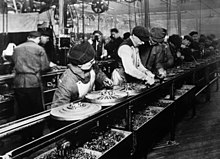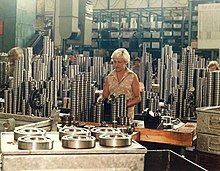Manufacturing
industrial activity producing goods for sale using labor and machines
(Redirected from Manufacturers)
Manufacturing is the production of merchandise for use or sale using labor and machines, tools, chemical and biological processing, or formulation.


Quotes
edit- Quotes are arranged alphabetically by author
A - F
edit- INDUSTRIAL DESIGN is destined to become a universal language ; for in our material age of rapid transition, from abstract, to applied, Science — in the midst of our extraordinary tendency towards the perfection of the means of conversion, or manufacturing production — it must soon pass current in every land.
- Jacques-Eugène Armengaud et al. The practical draughtsman's book of industrial design, 1851, Preface, p. ii-iv
- Cited in: American Railroad Journal, 1853, p. 445
- In short, intelligence, considered in what seems to be its original feature, is the faculty of manufacturing artificial objects, especially tools to make tools, and of indefinitely urging the manufacture.
- Henri Bergson, Creative Evolution (1907), Chapter II
- Cited in: David Kreps, Bergson, Complexity and Creative Emergence, 2015
- Mechanical engineering may be defined as the manufacture, installation, and repair of all kinds of machinery (including machine tools), prime movers and boilers, and engines.
- N. K. Buxton, Derek Howard Aldcroft (1979) British industry between the wars. p. 129
G - L
edit- A wide market awaited the manufacturer of food products who would set purity and quality above everything else in their preparation.
- Attributed to Henry J. Heinz in: J. N. Garfunkle (1910), The American Pure Food and Health Journal. Vol. 2 p. xxxviii
- The two main purposes of mechanical engineering are: first, to design and make tools and equipment for turning out machinery required by all branches of engineering, industry, and commerce, and, second, to design and manufacture, by means of said tools and equipment.
- Theodore Jesse Hoover, John Charles Lounsbury Fish (1941) The Engineering Profession. p. 133
M - R
edit- There are many branches of manufacturing industry which greatly depend for their success upon the designer's art, and it is necessary that the industrial designer should possess a knowledge of the processes of the manufacture in which his designs will be utilized, as well as of the properties and capabilities of the material to which they will be applied.
- Sir Philip Magnus. Industrial education, K. Paul, Trench, & co., 1888. p. 24; Cited in James Clarke's Americanized Encyclopaedia britannica, Belford-Clarke co., 1890, p. 5718
- We went through one of the big automobile factories to-day.... The foundry interested me particularly. The heat was terrific. The men seemed weary. Here manual labour is a drudgery and toil is slavery. The men cannot possibly find any satisfaction in their work. They simply work to make a living. Their sweat and their dull pain are part of the price paid for the fine cars we all run. And most of us run the cars without knowing what price is being paid for them.... We are all responsible. We all want the things which the factory produces and none of us is sensitive enough to care how much in human values the efficiency of the modern factory costs.
- Reinhold Niebuhr, Leaves from the Notebook of a Tamed Cynic pp. 79–80
- What gradually swung the balance of resources back in the Allies' favour were two factors: the sheer speed and scale of American rearmament, which dwarfed anything that the Germans and Japanese, or even the British, had thought possible: and the swift revival of the Soviet economy after the mauling it received in 1941, when it sustained losses so severe that most pundits assumed the worst. Without the extraordinary exodus of Soviet machinery and labour from the war zones of the western Soviet Union to the harsh plains of Siberia, Stalin's armies would have been like the Tsar's in 1916, the soldiers in the second rank picking up the guns and boots of their dead vanguard as they scurried into battle. Against every expectation Soviet society worked feverishly to turn out the tanks and aircraft their soldiers needed. With only a quarter of the steel available to Germany, Soviet industry turned out more tanks, gun and planes than her German enemy throughout the war.
- Richard Overy, Why the Allies Won (1995), p. 5
- The great cry that rises from our manufacturing cities, louder than their furnace blast, is all in very deed for this, — that we manufacture everything there except men; we blanch cotton, and strengthen steel, and refine sugar, and shape pottery; but to brighten, to strengthen, to refine, or to form a single living spirit, never enters into our estimate of advantages.
- John Ruskin The Stones of Venice (1853) Vol. II, ch. VI, section 16
- Cited in: Sir Humphry Davy, The collected works of Sir Humphry Davy ...: Discourses delivered before the Royal society. Elements of agricultural chemistry, pt. I, 1922, p. 112
S - Z
edit- Mechanical engineering is applicable rather to works connected with private enterprise, such as the designing and construction of steam machinery for the purposes of navigation and transportation, the adaptation of such machinery to mills and factories, the construction of water-wheels, the fabrication of materials, iron, steel, and brass, for the purposes of the engineer, the architect, and manufacturer ; and the manufacture of implements and machinery for agriculture, for mining, and for domestic purposes.
- William Pettit Trowbridge (1871) The Profession of the Mechanical Or Dynamical Engineer: An Inaugural Address Before the Sheffield Scientific School of Yale College. p. 5